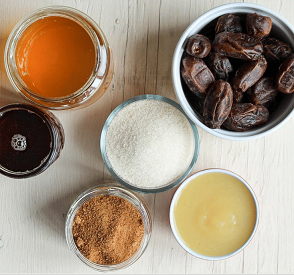Sweeteners

Sweeteners are substances added to food /drink to enhance their taste and enjoyment of them
Refined sugar use has dramatically increased over the last 100 years. However, more recently, sugar is being replaced with other carbohydrate sweeteners, especially high fructose corn syrup (HFCS), and non-carbohydrate natural and artificial sweeteners, such as stevia, aspartame, saccharin and sucralose.
Most sweeteners affect blood sugar levels to some degree. The effect of a sweetener on blood sugar and INSULIN levels depends on:
A slower rise in blood sugar and INSULIN enables us to burn fat and avoid weight gain long-term
Unfortunately, even though artifical sweeteners have a 0 glycemic rating, they may still raise blood sugar due to other indirect effects. E.g. being toxic to gut bacteria;
Artifical non-nutritive sweeteners cause weight gain
Some sweeteners linked to diabetes, obesity and tooth decay
Also known as caloric or carbohydrate sweeteners, they include plain old "sugar". Nutritive sweeteners provide energy-supplying carbohydrates. Some sugars are naturally contained in foods, such as fruit (which, unlike refined table sugar, also supply vitamins and minerals; fruit with highest sugar content are (highest first) figs, grapes, mangos, cherries and bananas), however, most of our dietary sugar carbohydrate comes from nutritive sweeteners added to commercial products and home-made foods to enhance flavor and texture, and increase shelf-life.
A chart of nutritive sweeteners and more about them: Chart / Info.: Nutritive sweeteners
The newcomers to the sweetener market are those with low or no calories, but not necessarily low-glycemic. Non-nutritive sweeteners (NNS) have zero/ low calories, however, this does not necessarily mean they are low-glycemic sweeteners (LGS), having a low-glycemic effect on blood sugar when digested/metabolized by the body. Some do, some don't.
There are 3 types of NNS: Natural / plant NNS, Sugar alcohol NNS and non-nutritive artificial sweeteners (NAS).
ALL FDA-approved artificial sweeteners are toxic to gut bacteria. This significantly affects the gut microbiome, which has serious consequences for our health.
Artificial sweeteners actually cause weight gain
Non-nutritive artificial sweeteners (NAS) toxic to gut bacteria increasing risk of prediabetes
Chart / Info: Non-nutritive sweeteners
The National Health and Nutrition Examination Survey (NHANES 2009-2012)
Sylvetsky, A.C.; Jin, Y.; Clark, E.J.; Welsh, J.A.; Rother, K.I.; Talegawkar (2017) S.A. Consumption of Low-Calorie Sweeteners among Children and Adults in the United States. J. Acad. Nutr. Diet. 117, 441-448. PubMed
Malik, V.S.; Li, Y.; Pan, A.; De Koning, L.; Schernhammer, E.; Willett, W.C.; Hu, F.B. Long-Term Consumption of Sugar-Sweetened and Artificially Sweetened Beverages and Risk of Mortality in US Adults. Circulation 2019, 139, 2113-2125. PubMed
http://www.nutrientsreview.com/articles/sweeteners.html
Pereira, M.A. Diet beverages and the risk of obesity, diabetes, and cardiovascular disease: A review of evidence. Nutr. Rev. 2013, 71, 433-440. PubMed
Vyas, A.; Rubenstein, L.; Robinson, J.; Seguin, R.A.; Vitolins, M.Z.; Kazlauskaite, R.; Shikany, J.M.; Johnson, K.C.; Snetselaar, L.; Wallace, R. Diet drink consumption and the risk of cardiovascular events: A report from the Women'sHealth Initiative. J. Gen. Intern. Med. 2015, 30, 462-468. PubMed
http://www.sugar-and-sweetener-guide.com/sweetener-values.html